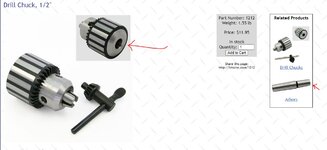billgtx
Member
Hi all. I have a Nova Comet II lathe bought a little over a year ago. Bought the Nova G3 chuck, drill chuck, etc at the same time because I didn't have a drill press. Have probably made 50 or so pens and my wife has probably made 20 or so. We use a typical pen mandrel for the pens although I've recently moved to turning between centers.
Recently I tried my hand at making some rings. Was using the G3 chuck to hold a 2x2 piece of wood to turn a ring mandrel and noticed there was a slight wobble in the chuck. Since I'm not sure if this will cause issues when I remount the ring mandrel after taking it off, I decided to run some tests. At first I was just using eyesight and there is a barely noticeable wobble in the body of the chuck but the jaws seemed to have a noticeable wobble.
So I bought a dial indicator and took some measurements. If my descriptions aren't clear I'm happy to post some pics or take video.
Dial indicator at the body of the chuck (between the tightening holes and the jaw slides. I get about 5-6 thousandths of movement. If it matters, the peak and valley are right near the #2 and #4 slides.
Dial indicator on the jaws fully closed - right at about 9 thousandths.
I have a spur center that came with the lathe. Put that in and measured the runout at 2 thousandths. Does this indicate the spindle, bearings and morse taper are OK?
Put in my drill chuck and measured at the jaw housing - I get 4 thousandths.
I also bought the Patrick Adair ring mandrels and put one in the drill chuck and measured 5 thousandths at the ring furthest out.
How do you read this information? Any other tests I can do? The only other thing I have that screws on to the spindle is the face plate that came with the lathe. Wasn't sure if it was constructed with enough precision to do a runout test on the body.
Thoughts? Do I have a bad chuck? Can it be improved?
Many thanks!
PS. Apologies on this as my first post. I joined after buying my lathe but was more of a lurker than anything. Again, thanks.
Recently I tried my hand at making some rings. Was using the G3 chuck to hold a 2x2 piece of wood to turn a ring mandrel and noticed there was a slight wobble in the chuck. Since I'm not sure if this will cause issues when I remount the ring mandrel after taking it off, I decided to run some tests. At first I was just using eyesight and there is a barely noticeable wobble in the body of the chuck but the jaws seemed to have a noticeable wobble.
So I bought a dial indicator and took some measurements. If my descriptions aren't clear I'm happy to post some pics or take video.
Dial indicator at the body of the chuck (between the tightening holes and the jaw slides. I get about 5-6 thousandths of movement. If it matters, the peak and valley are right near the #2 and #4 slides.
Dial indicator on the jaws fully closed - right at about 9 thousandths.
I have a spur center that came with the lathe. Put that in and measured the runout at 2 thousandths. Does this indicate the spindle, bearings and morse taper are OK?
Put in my drill chuck and measured at the jaw housing - I get 4 thousandths.
I also bought the Patrick Adair ring mandrels and put one in the drill chuck and measured 5 thousandths at the ring furthest out.
How do you read this information? Any other tests I can do? The only other thing I have that screws on to the spindle is the face plate that came with the lathe. Wasn't sure if it was constructed with enough precision to do a runout test on the body.
Thoughts? Do I have a bad chuck? Can it be improved?
Many thanks!
PS. Apologies on this as my first post. I joined after buying my lathe but was more of a lurker than anything. Again, thanks.

